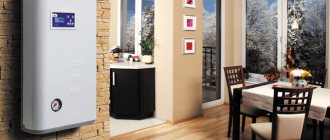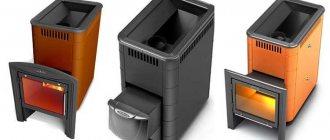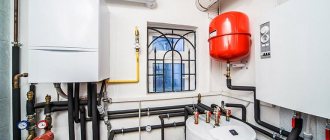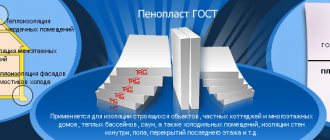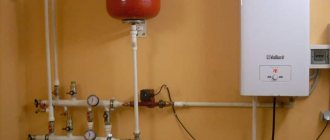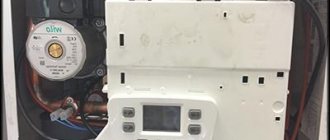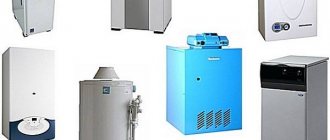Home / Electric boilers
Back
Published: 05/20/2019
Reading time: 3 min
0
11120
To heat residential and office premises, equipment with an electric water heater is used. To ensure a balance of temperature and energy consumption, the electric boiler is calculated. When determining operating parameters, not only the area of the rooms is taken into account, but also the physical properties of the materials of the walls, floor and ceiling of the room.
- 1 What is the power of an electric boiler
- 2 Methods for determining the power of an electric boiler 2.1 Calculation of the boiler based on the area of the house
- 2.2 Calculation of boiler power by volume
- 2.3 Calculation for DHW
What does power consumption depend on?
The size of the boiler's electrical power is influenced by a number of interrelated quantities. For average calculations, the ceiling height in the house is taken to be up to 3 m, then the calculation can be reduced to a simple ratio: 1 kW of boiler power will provide heating for 10 m2 of building area.
This formula allows you to quite accurately determine how much electricity an electric boiler installed in the climatic region of central Russia consumes.
For a more accurate calculation, it is necessary to additionally take into account correction factors for the following indicators:
- material and technical condition of window products, doors and floor coverings;
- material of wall structures;
- roofing material and design;
- building insulation system;
- climatic region.
If the house is blown from all sides, then 5 kW per 10 m2 will probably not be enough for the owner. Energy saving of a heating facility is an indispensable condition for the operation of such a boiler and it directly depends on the high-quality thermal insulation of the heating facility’s structure and compliance with the requirements of construction technology during its construction.
Experts do not advise choosing a boiler unit with a large power reserve, since this leads to excessive consumption of electricity; the maximum reserve should be in the range from 15% to 25%.
Electric boiler power for heating 150 m2
What power should an electric boiler have to heat a private house of 150 m2? Is a thermal power reserve required for this area? Is it possible to use a low-power heating unit?
Well, firstly, the standard statement that for every 10 square meters of area you will need 1 kW of boiler thermal power, it is worth recognizing as “a little wrong.”
Why? Because the store manager who advises you doesn’t see your house, doesn’t know its heat loss, and doesn’t even know how high your ceilings are.
He, the manager, simply says “15 kW” and that’s it. That's how he was taught. What about thinking?
Look, the ceilings in the house are 220 cm and 300 cm. What difference do you think? To heat a second house with the same area and the same insulation of the building envelope, you will need an electric boiler that is almost 1.5 times more powerful.
Why? Because in the end, any heat generator, through its own heating or through radiators / heated floors, heats the air in the interior.
How is the volume of the premises and, as a result, the air in them measured? That's right, in cubic meters.
This means that it is incorrect to select the power of an electric boiler for 150 m2. And correctly - 300 m3 or 450 m3. This already depends on the height of your ceilings.
Calculation of electricity consumption by the boiler per day and per month
Almost all innovative electric boilers have an efficiency of 99% or more. This means that under load, a 10 kW boiler will consume 10.101 kW of electricity.
This power is enough to heat a residential building with an area of 100 m2. The amount of heat energy spent on heating a living space largely depends on the ambient air temperature outside. Of course, the lower it is, the greater the energy consumption.
Consumption based on m2 of house area
In order to find out how much an electric heating boiler consumes per month, first determine the daily electricity consumption.
The maximum possible consumption of such a boiler per day is: 24 * 10.101 = 242.42 kW.
In price terms, as of the end of 2021 and the electricity tariff for the Moscow region, daily costs will be:
242.42 * 5.56 = 1347.87 rubles/day.
The electricity consumption of an electric boiler for heating a private house per month will be:
1347.87 * 30 = 40410 rubles/month.
During the heating season from October 15 to March 31, that is, for 136 heating days, the owner will have to pay for electricity to heat the house:
1347.87*136= 183310 rub.
However, this is a maximum estimate. In fact, low outside temperatures do not occur every day. Approximately, during the heating season, an electric boiler consumes approximately 40-50% of the maximum load.
Thus, the real costs for electric heating of 100 m2 of area in the central zone of Russia per season will be:
183310 * 0.5 = 91655 rub.
Who is suitable for electric heating?
So, summing up and summing up all of the above, we can safely draw conclusions that electric heating is suitable in a number of such cases:
- When the housing is well insulated and there are no drafts;
- When the cost of coal and firewood is higher than the cost of electricity;
- If there is a need to save both time and money;
- There is no time to tinker with stove heating;
- It is possible to pay less for electricity, at the so-called double tariff;
- If your region does not have cold winters, and the outside temperature rarely drops below -10 degrees.
The last point, in general, makes it possible to heat your home with electric convectors or air conditioners. Installing a heat pump will also help here, although its purchase and installation will cost a large amount. But in just a few years you will be able to recoup all the costs of installing a heat pump, which, consuming 2 kW, can produce as much as 6 kW for home heating needs.
Rate this article and share the link:
Ways to reduce electric boiler consumption
A thrifty owner will always try to reduce heating costs while maintaining a comfortable temperature in the house. Of course, for this you need to take various heat-protective measures and adjust the boiler equipment.
The most common methods for optimizing the electric heating system of a residential building:
- The most effective option that affects energy consumption is thermal insulation of the walls of the house. Too much thermal energy is wasted in old windows. High-tech PVC windows with multi-layer air chambers significantly reduce the consumption of heat production. The walls of buildings are insulated with effective heat-protective building materials with low thermal conductivity - polystyrene foam, mineral wool and others. It is also necessary to insulate the foundation and roof of the house.
- The transition to paying for electricity using multi-tariff metering is a fairly cost-effective measure. In this case, the boiler unit operates at night during the hours of minimum electricity consumption at the lowest tariff.
- Introduction of automatic electric boiler control devices. Reducing the load on the boiler in standby heating mode when users are not at home.
In order to automate the operation of the boiler, it is possible to use programmable electronic thermostats or boilers with built-in software. Automation adjusts the boiler equipment to a thermal mode that consumes minimal energy consumption. - Installation of a circulation pump to speed up the movement of the coolant. As a result, the heated coolant operates at a low temperature, which will increase the efficiency of the boiler and the service life.
- Use of a weather-compensated control system. Its meaning is that the electrical signal from the primary sensor to change the thermal operating mode of the electric boiler is sent to the heating elements when the outside air temperature changes. Consequently, with an increase in the outside ambient temperature, the boiler reduces thermal output, and, therefore, energy consumption. Therefore, there is no unnecessary generation of thermal energy. Weather-dependent regulation by an electric boiler simultaneously with home thermostats or thermostatic valves makes it possible to achieve a tangible effect on the economical operation of equipment.
- Use of ventilation with recovery. Such a device returns to the house all the thermal energy that was previously lost along with warm room air during the ventilation period. When using such high-power complexes, there is no need to open windows at all for ventilation. With this method of air purification, the humidity and cleanliness of the surrounding air will be maintained at a sanitary level.
In conclusion, it should be noted that electric heating of a house is still a fairly high-cost method, regardless of the specific technology and design of the electric boiler.
It is used exclusively in situations where it is not possible to connect the object to the gas main. However, by installing electric heating correctly, in compliance with norms and standards, equipping the boiler with modern control and protection devices, and also providing good thermal protection of the building, you can ensure that the heating system operates in an efficient mode, while ensuring warmth and comfort in the house.
How to heat a house with electricity
We would like to draw your attention as a potential buyer to the production in the Republic of Belarus of this type of electric heaters based on quartz sand as quartz. The power of the produced models ranges from 0.25-0.65 W! Heating takes 20 minutes to a surface temperature of +95°C, and cooling and exchange of accumulated thermal energy with air after switching off takes up to 1 hour. Earnestly! But this is not all the advantages of this modification. A completely new model is currently being produced which is equipped with a built-in electronic thermostat with a display with dual climate control functions. The first indoor climate control function regulates the air temperature in the range from +5°C to +35°C. The second function of the thermostat is responsible for heating the surface of the heater from +40°C to +95°C. Example. You have set the room air temperature on the thermostat to +23°C, and the heating surface temperature of the stove to +90°C. In this option, the electric heater, having heated the surface to a set temperature in 20 minutes, will turn it off from electricity consumption until its surface cools by 1°C, and then start working again. This will happen until the air in the room warms up to the temperature you previously programmed +23°C. The cooling time of the heater surface by 1°C is 1.5 minutes, and the time of reheating the hot device by 1°C is 0.40 minutes. Thus, a device with a power of 0.45 W consumes only 0.22 kW/hour. One degree of cooling on the surface of a quartz heater saves up to 50% of electricity . This is a good and noteworthy result of the Belarusian manufacturer of the Teplopitbel trademark.
Advantages of electric heating
- Simple installation - if you are able to hang a shelf yourself or change the hose in the washing machine, then installing an electric boiler will not be difficult for you.
- Economical and quick installation - no need to order an expensive project and have it approved by government authorities, or wait for a certificate to start operating the system.
- Safety – during operation of the electric boiler and convectors there is no danger of explosion and there are no combustion products.
- Easy operation of an electric boiler compared to a gas or solid fuel one.
- There is no need to conduct any communications to the house - to connect you only need electricity and water. There is no need to dig trenches or lay pipes underground.
- The system does not require a chimney or a safety sensor system.
Video from the Teplopitbel company - do-it-yourself assembly of an electric radiator from an old cast-iron battery with non-freezing liquid (antifreeze) using an electric radiator control unit of our own production.
Other options for heating a private house with electricity
These include traditional methods as well as modern technologies.
Oil heaters
Well-known mobile devices for heating air in rooms with a volume of 10–12 m² with a power of 1.5 kW, with an area of 30 m² - already at 3.0 kW. They can work for up to several days in a row, are absolutely silent, and do not emit odor or burning.
They have a built-in thermostat that saves energy and accurately maintains the required temperature with periodic independent switching on and off.
Note: not recommended in rooms with an area of less than 4.0 m² and in places with high humidity.
Electric convectors
This simple and inexpensive heating of a private house with electricity can warm the air inside well. The operation of the devices is based on the principle of circulating and heating air from a heating element and a radiator between two panels. The power of the heating element is in the range of 0.5–3 kW. Overheating is controlled by special sensors.
Infrared heat emitters
This method is not only progressive, but also a kind of design. Heaters of this type can be on a stand like a chandelier, in the form of decorative panels on the wall, or baseboards. An infrared fireplace gives the room a special chic - it will heat the room and create the illusion of a real home, consuming a maximum of 2.0 kW/h.
Unlike the considered system options, the emitters heat objects rather than air and therefore operate pointwise or zonally. This is especially valuable when you want to increase the temperature in a specific area without compromising the overall comfort of the room.
Heaters are divided into light and long-wave. The former are capable of heating up to over 600⁰C and are used where a lot of heat is needed, the latter, with heating up to 600⁰C, are optimal when designing heating of a private house with electricity for small rooms.
Warm electric floor
One of the effective achievements of recent years. Creates a comfortable thermal regime at the floor level, but the higher it is, the air temperature noticeably decreases.
Electric heating cable is a classic of underfloor heating, most often used as the main heat supply for rooms. Its variety is heating cable mats under the floor covering in certain areas or as an additional heating system.
Note: intertwining of cable cores during installation is not allowed under any circumstances!
Heating mats with carbon rods form a group of infrared heat-generating floors. Even furniture can be placed on such ready-made floor structures, and their installation is possible not only under ceramic tiles, but even under linoleum and laminate.
